Evaluation of Lead Release in a Simulated Lead-Free Premise Plumbing System Using a Sequential Sampling Approach
Abstract
:1. Introduction
2. Materials and Methods
2.1. Simulated Premise Plumbing System
2.2. Analytical Methods
3. Results and Discussion
3.1. Conditioning Phase
3.2. Orthophosphate Addition
3.3. Change in Solution pH
3.4. Scale Analysis
4. Conclusions
Acknowledgments
Author Contributions
Conflicts of Interest
Abbreviations
| AS/NZS | Australian/New Zealand Standard |
| BS EN | British Standards in English language |
| CP | Code of Practice |
| CSMR | chloride-to-sulfate mass ratio |
| ICP-OES | Inductively coupled plasma mass spectrometer optical emission spectrometry |
| IRIS | Integrated Risk Information System |
| LCR | Lead and Copper Rule |
| LSLs | lead service lines |
| MCLG | Maximum Contaminant Level Goal |
| PUB | Public Utilities Board |
| RDT | random daytime |
| RfD | reference dose |
| USEPA | United States Environmental Protection Agency |
| WHO | World Health Organization |
References
- Bellinger, D.; Leviton, A.; Sloman, J.; Rabinowitz, M.; Needleman, H.L.; Waternaux, C. Low-level lead exposure and children’s cognitive function in the preschool years. Pediatrics 1991, 87, 219–227. [Google Scholar] [PubMed]
- Weizsaecker, K. Lead toxicity during pregnancy. Primary Care Update OB/GYNS 2003, 10, 304–309. [Google Scholar] [CrossRef]
- Papanikoloaou, N.C.; Hatzidaki, E.G.; Boonsalee, S.; Txanakakis, G.N.; Tsatsakis, A.M. Lead toxicity update. A brief Review. Med. Sci. Monit. 2005, 11, RA329–RA336. [Google Scholar]
- U.S. Environmental Protection Agency. Prohibition on Use of Lead Pipes, Solder and Flux. Available online: https://www.gpo.gov/fdsys/pkg/CFR-1999-title40-vol15/xml/CFR-1999-title40-vol15-sec141-43.xml (accessed on 24 February 2016).
- U.S. Environmental Protection Agency. Maximum Contaminant Level Goals and National Primary Drinking Water Regulations for Lead and Copper. Available online: http://www.epa.gov/dwreginfo/lead-and-copper-rule (accessed on 24 February 2016).
- World Health Organization. Water Sanitation and Health: Guidelines for Drinking-Water Quality; WHO: Geneva, Switzerland, 2011. [Google Scholar]
- Renner, R. Reaction to the solution: Lead exposure following partial service line replacement. Environ. Health Perspect. 2010, 118, A202–A208. [Google Scholar] [CrossRef] [PubMed]
- Health Canada. Minimizing Exposure to Lead from Drinking Water Distribution Systems. Available online: http://www.hc-sc.gc.ca/ewh-semt/alt_formats/hecs-sesc/pdf/pubs/water-eau/lead-plomb-eng.pdf (accessed on 24 November 2015).
- Drinking Water Inspectorate. Lead in Drinking Water. Available online: http://dwi.defra.gov.uk/consumers/advice-leaflets/lead.pdf (accessed on 24 November 2015).
- U.S. Environmental Protection Agency. Reducing Lead in Drinking Water: A Benefit Analysis; USEPA: Washington, DC, USA, 1986.
- LEAD. Lead in Drinking Water in Australia: Hazards Associated with Lead Based Solder on Pipes. Available online: http://www.lead.org.au/lanv8n1/l8v1-11.html (accessed on 24 November 2015).
- Renner, R. Out of plumb when water treatment causes lead contamination. Environ. Health Perspect. 2009, 117, A542–A547. [Google Scholar] [CrossRef] [PubMed]
- Edwards, M.; Triantafyllidou, S. Chloride-to-sulfate mass ratio and lead leaching to water. J. Am. Water Works Assoc. 2007, 99, 96–109. [Google Scholar]
- Willison, H.; Boyer, T.H. Secondary effects of anion exchange on chloride, sulfate, and lead release: Systems approach to corrosion control. Water Res. 2012, 46, 2385–2394. [Google Scholar] [CrossRef] [PubMed]
- Ng, D.Q.; Lin, Y.P. Effects of pH value, chloride and sulfate concentrations on galvanic corrosion between lead and copper in drinking water. Environ. Chem. 2015. [Google Scholar] [CrossRef]
- Kimbrough, D.E. Brass corrosion as a source of lead and copper in traditional and all plastic distribution systems. J. Am. Water Works Assoc. 2007, 99, 70–76. [Google Scholar]
- Elfland, C.; Scardina, P.; Edwards, M. Lead-contaminated water from brass plumbing devices in new buildings. J. Am. Water Works Assoc. 2010, 102, 66–76. [Google Scholar]
- U.S. Environmental Protection Agency. Summary of the Reduction of Lead in Drinking Water Act and Frequently Asked Questions; USEPA: Washington, DC, USA, 2013.
- CDA. Copper Casting Alloys. Available online: http://www.copper.org/publications/pub_list/pdf/7014.pdf (accessed on 24 November 2015).
- CDA. Alloy Data Sheet, Envirobrass (SeBiLOY), Non-Leaded Red Brass and Yellow Brass Casting Alloy. Available online: http://www.copper.org/applications/industrial/PDF_files/sebiloy.PDF (accessed on 24 November 2015).
- U.S. Environmental Protection Agency. National Primary Drinking Water Regulations for Lead and Copper: Short-Term Regulatory Revisions and Clarifications. Available online: https://www.federalregister.gov/articles/2007/10/10/E7-19432/national-primary-drinking-water-regulations-for-lead-and-copper-short-term-regulatory-revisions-and (accessed on 24 February 2016).
- Sandvig, A.; Kwan, P.; Kirmeyer, G.; Maynard, B.; Mast, D.; Trussell, R.; Trussell, S.; Cantor, A.; Prescott, A. Contribution of Service Line and Plumbing Fixtures to Lead and Copper Rule Compliance Issue; AwwaRF: Denver, CO, USA, 2008. [Google Scholar]
- Hoekstra, E.J.; Hayes, C.R.; Aertgeerts, R.; Becker, A.; Jung, M.; Postawa, A.; Russell, L.; Witczak, S. Guidance on Sampling and Monitoring for Lead in Drinking Water; European Commission, Joint Research Centre, Institute for Health and Consumer Protection: Luxembourg, Luxembourg, 2009. [Google Scholar]
- Van den Hoven, T.; Slaats, N. Lead monitoring. In Analytical Methods for Drinking Water, Advances in Sampling and Analysis; Quevaullier, P., Thompson, K.C., Eds.; Wiley & Sons: Oxford, UK, 2006; pp. 63–113. [Google Scholar]
- Hayes, C.R.; Incledion, S.; Balch, M. Experience in Wales (UK) of the optimization of ortho-phosphate dosing for controlling lead in drinking water. J. Water Health 2008, 6, 177–185. [Google Scholar] [CrossRef] [PubMed]
- Government of Ontario. Ontario Regulation 399/07. Safe Drinking Water Act, 2002—Amended to O. Reg. 170/03; Government of Ontario: Ontario, Canada, 2007.
- Ministry of Sustainable Development, Environment and Parks (MDDEP). Rules on Drinking Water Qaulity. Available online: http://www2.publicationsduquebec.gouv.qc.ca/dynamicSearch/telecharge.php?type=3& file=/Q_2/ Q2R40.HTM (accessed on 25 February 2016).
- Public Utilities Board. Handbook on Application for Water Supply, 2009. Available online: http://www.pub.gov.sg/general/Documents/RPUB00003.pdf (accessed on 3 February 2016).
- Public Utilities Board. Compression and Capillary Pipe Fittings. Available online: https://app.pub.gov.sg/WaterFittingsUsers2/WaterWsFittingStdDesc.aspx?fd=Compression%20and%20Capillary%20Pipe%20Fittings&l1=2&l2=8&l3=4-2&l4=5 (accessed on 3 February 2016).
- Housing & Development Board. 2012, Annual Report, Key Statistics. Available online: http://www10.hdb.gov.sg/eBook/AR2012/keystatistics.html (accessed on 4 February 2016).
- Triantafyllidou, S.; Parks, J.; Edwards, M. Lead particles in potable water. J. Amer. Water Works Assoc. 2007, 99, 107–117. [Google Scholar]
- Public Utility Board. Handbook on Application For Water Supply; PUB: Singapore, Singapore, 2009.
- American Public Health Association; American Water Works Association; Water Environment Federation. Standard Methods for the Examination of Water and Wastewater; APHA, AWWA and WEF: Washington, DC, USA, 2012. [Google Scholar]
- Boffardi, B.P. Potable water treatment and monitoring for corrosion and scale control. J. NEWWA. 1988, 102, 111–116. [Google Scholar]
- Edwards, M.; Mcneill, L.S. Effect of phosphate inhibitors on lead release from pipes. J. Am. Water Works Assoc. 2002, 94, 79–90. [Google Scholar]
- Hayes, C.; Aertgeerts, R.; Barrott, L.; Becker, A.; Benoliel, M.J.; Croll, B.; Edwards, M.; Gari, D.; Hoekstra, E.; Jung, M.; et al. Best Practice Guide on the Control of Lead in Drinking Water; Hayes, C., Ed.; IWA Publishing: London, UK, 2010. [Google Scholar]
- Schock, M.R.; Wagner, I.; Oliphant, R. The corrosion and solubility of lead in drinking water. In Internal Corrosion of Water Distribution Systems, 2nd ed.; American Water Works Association Research Foundation: Denver, CO, USA, 1996. [Google Scholar]
- Zhang, P.; Ryan, J.; Bryndzia, L.T. Pyromorphite formation from goethite adsorbed lead. Environ. Sci. Technol. 1997, 31, 2673–2678. [Google Scholar] [CrossRef]
- Zhang, P.; Ryan, J. Transformation of Pb(II) from cerussite to chloropyromorphite in the presence of hydroxyapatite under varying conditions of pH. Environ. Sci. Technol. 1999, 33, 625–630. [Google Scholar] [CrossRef]
- Zhang, P.; Ryan, J. Formation of chloropyromorphite from galena (PbS) in the presence of hydroxyapatite. Environ. Sci. Technol. 1999, 33, 618–624. [Google Scholar] [CrossRef]
- Scheckel, K.G.; Ryan, J. Effects of aging and pH on dissolution kinetics and stability of chloropyromorphite. Environ. Sci. Technol. 2002, 36, 2198–2204. [Google Scholar] [CrossRef] [PubMed]
- Schock, M.R.; Lytle, D.A.; Sandvig, A.M.; Clement, J.; Harmon, S.M. Replacing polyphosphate with silicate to solve lead, copper, and source water iron problems. J. Am. Water Works Assoc. 2005, 97, 84–93. [Google Scholar]
- Lytle, D.A.; Schock, M.R.; Scheckel, K. The inhibition of Pb(IV) oxide formation in chlorinated water by orthophosphate. Environ. Sci. Technol. 2009, 43, 6624–6631. [Google Scholar] [CrossRef] [PubMed]
- Schock, M.R.; Lytle, D.A.; Clement, J.A. Effect of pH, DIC, Orthophosphate and Sulfate on Drinking Water Cuprosolvency; Office of Research & Development, USEPA: Cincinnati, OH, USA, 1995.
- Yohai, L.; Schreiner, W.H.; Vazquez, M.; Valcarce, M.B. Surface characterization of copper, zinc and brass in contact with tap water inhibited with phosphate ions. Appl. Surf. Sci. 2011, 257, 10089–10095. [Google Scholar] [CrossRef]
- Scheckel, K.G.; Ryan, J.A. In vitro formation of pyromorphite via reaction of Pb sources with soft-drink phosphoric acid. Sci. Total Environ. 2003, 302, 253–265. [Google Scholar] [CrossRef]
- Lucey, V.F. Relationship between water composition and dezincification of duplex brass. In Proceedings of the British Non-Ferrous Metals Research Association Seminar on Dezincification in Brass Fittings for Water Services, Copenhagen, Denmark, 10–11 September 1973.
- Oliphant, R.J. Dezincification by Potable Water of Domestic Plumbing Fittings: Measurement and Control; Water Research Centre: Medmenham, UK, 1978. [Google Scholar]
- Oliphant, R.J.; Schock, M.R. Copper alloys and solders. In Internal Corrosion of Water Distribution Systems, 277; American Water Works Association: Denver, CO, USA, 1996. [Google Scholar]
- Zhang, Y.; Edwards, M. Effects of pH, chloride, bicarbonate and phosphate on brass dezincification. J. Am. Water Works Assoc. 2011, 103, 90–102. [Google Scholar]
- Zhang, Y.; Edwards, M. Zinc content in brass and its influence on lead leaching. J. Am. Water Works Assoc. 2011, 103, 76–83. [Google Scholar]
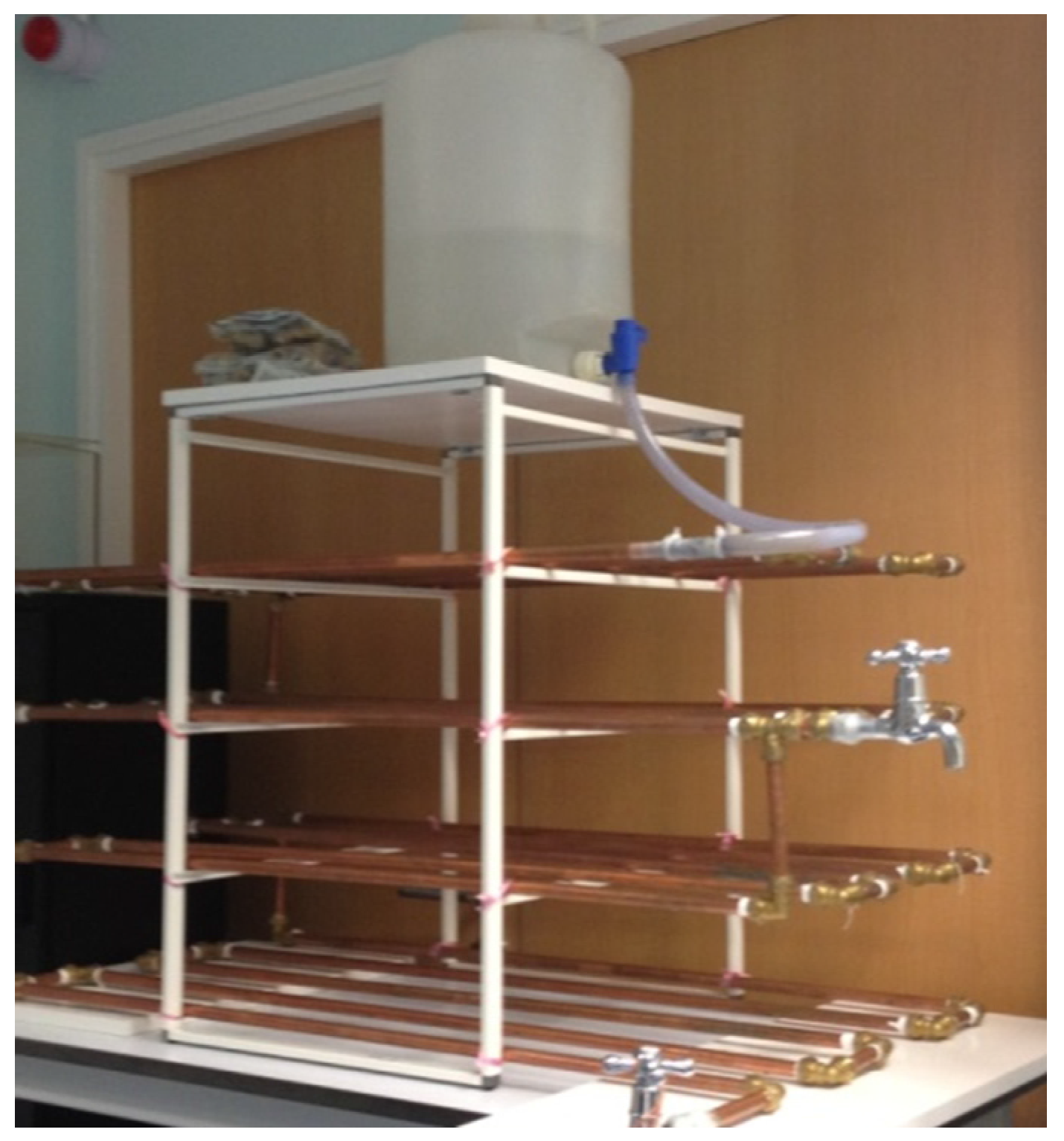
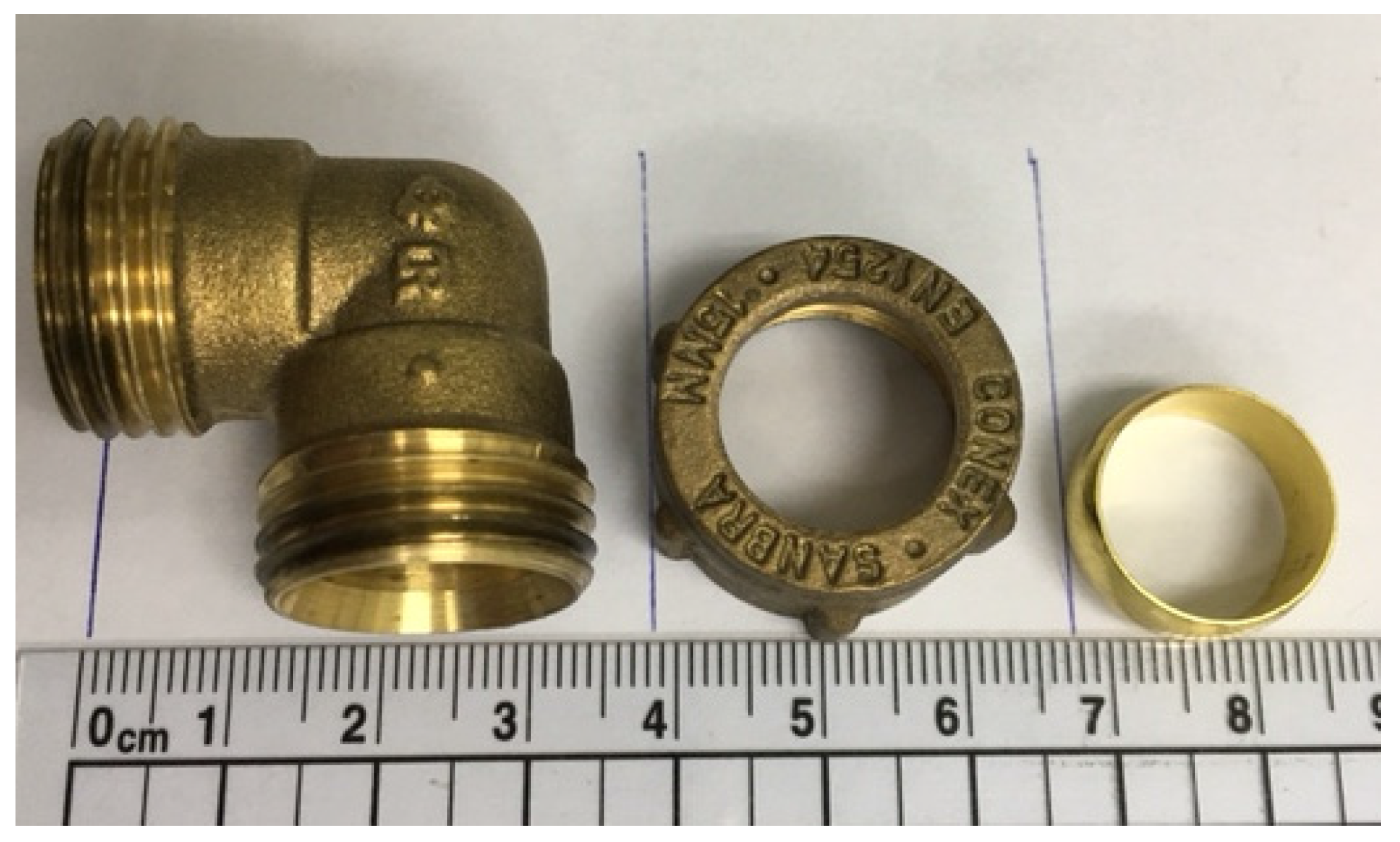
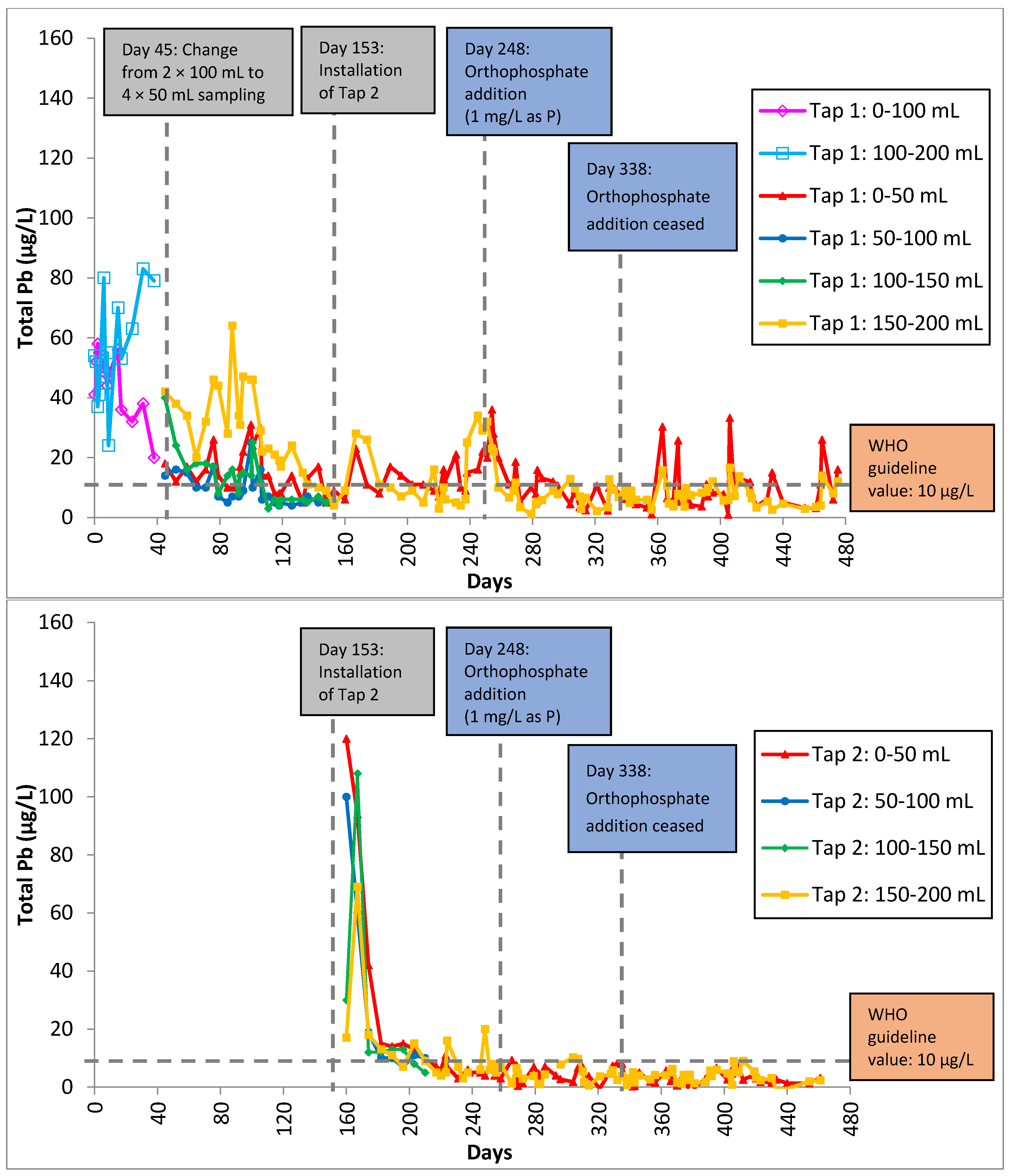
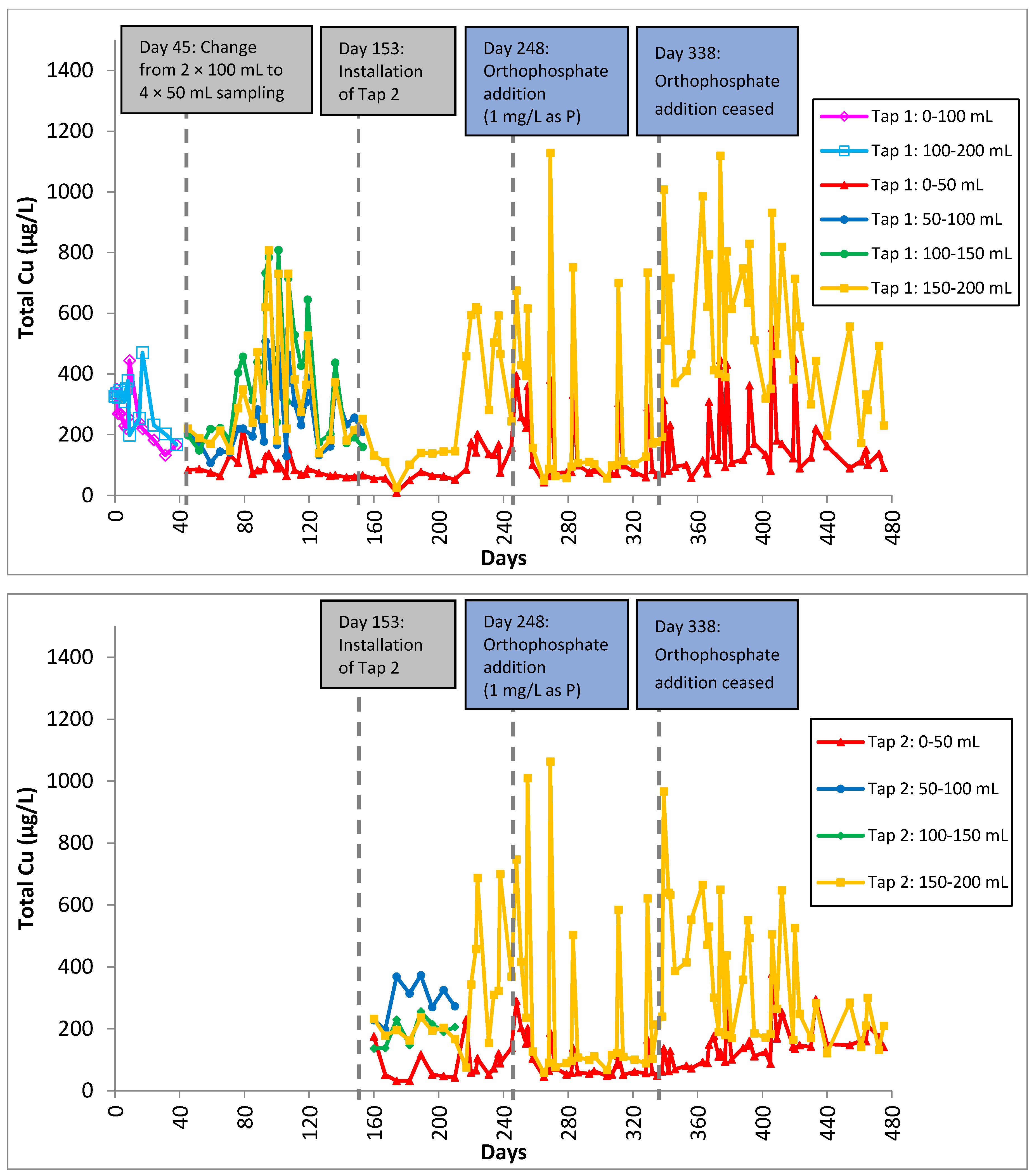
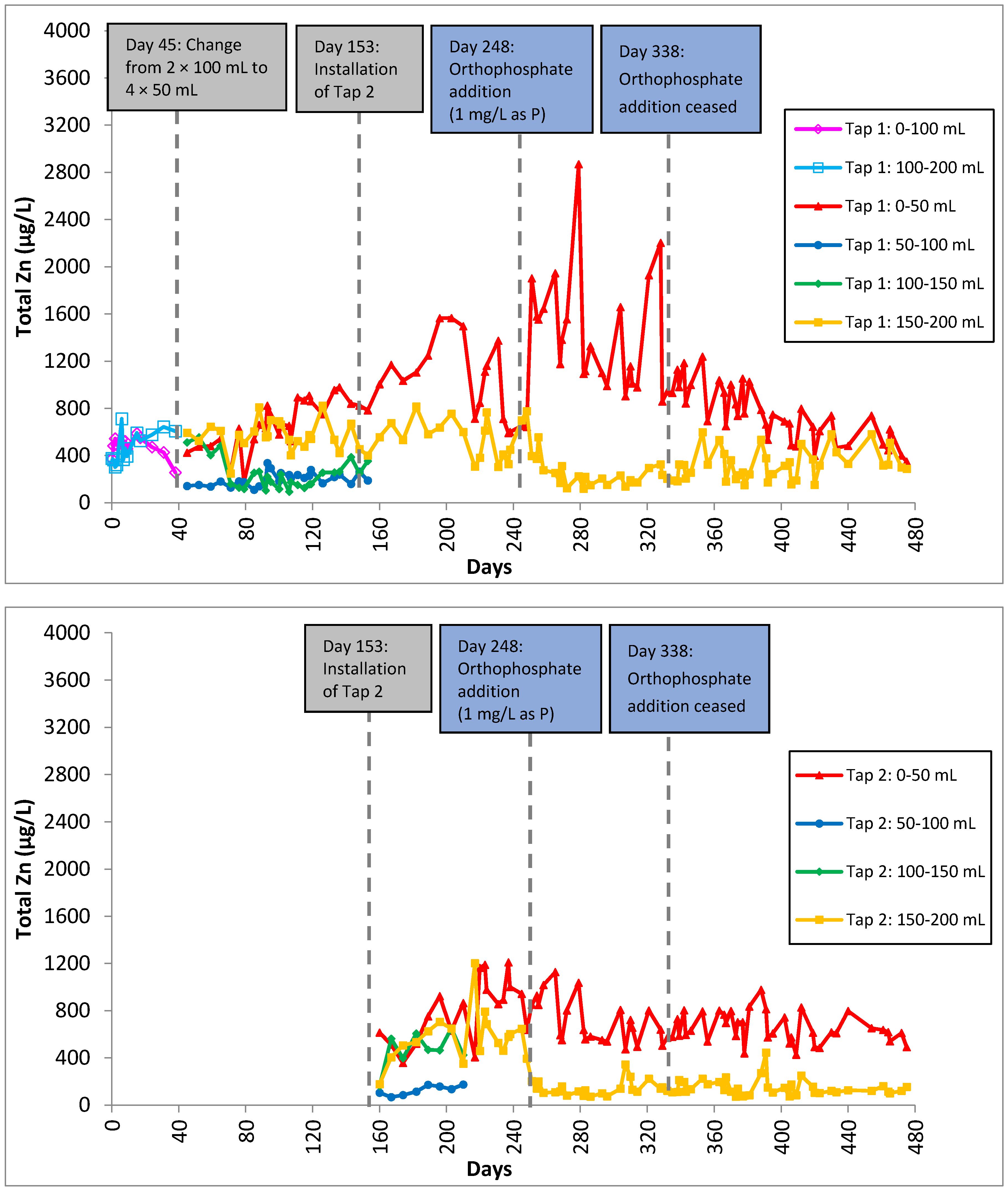
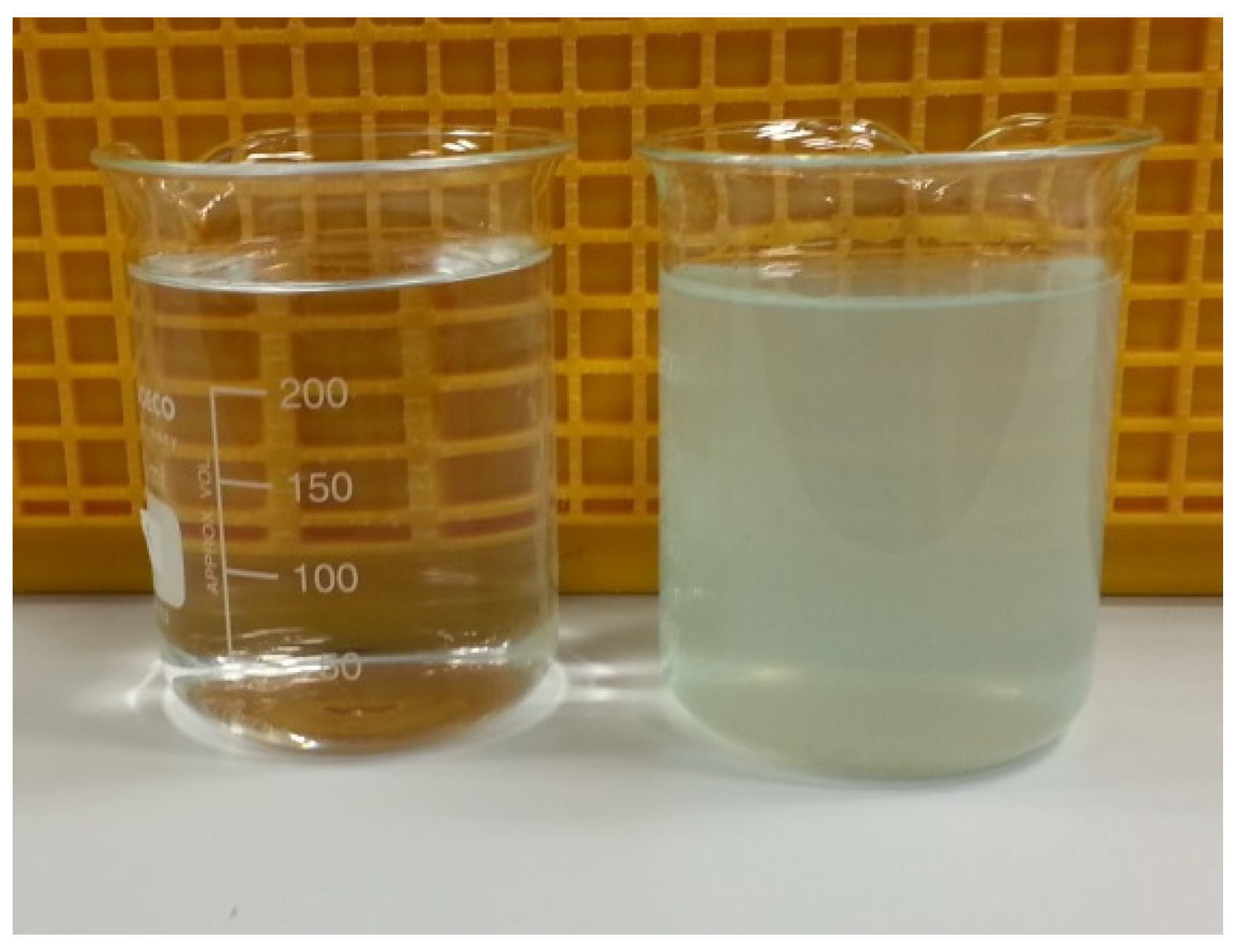

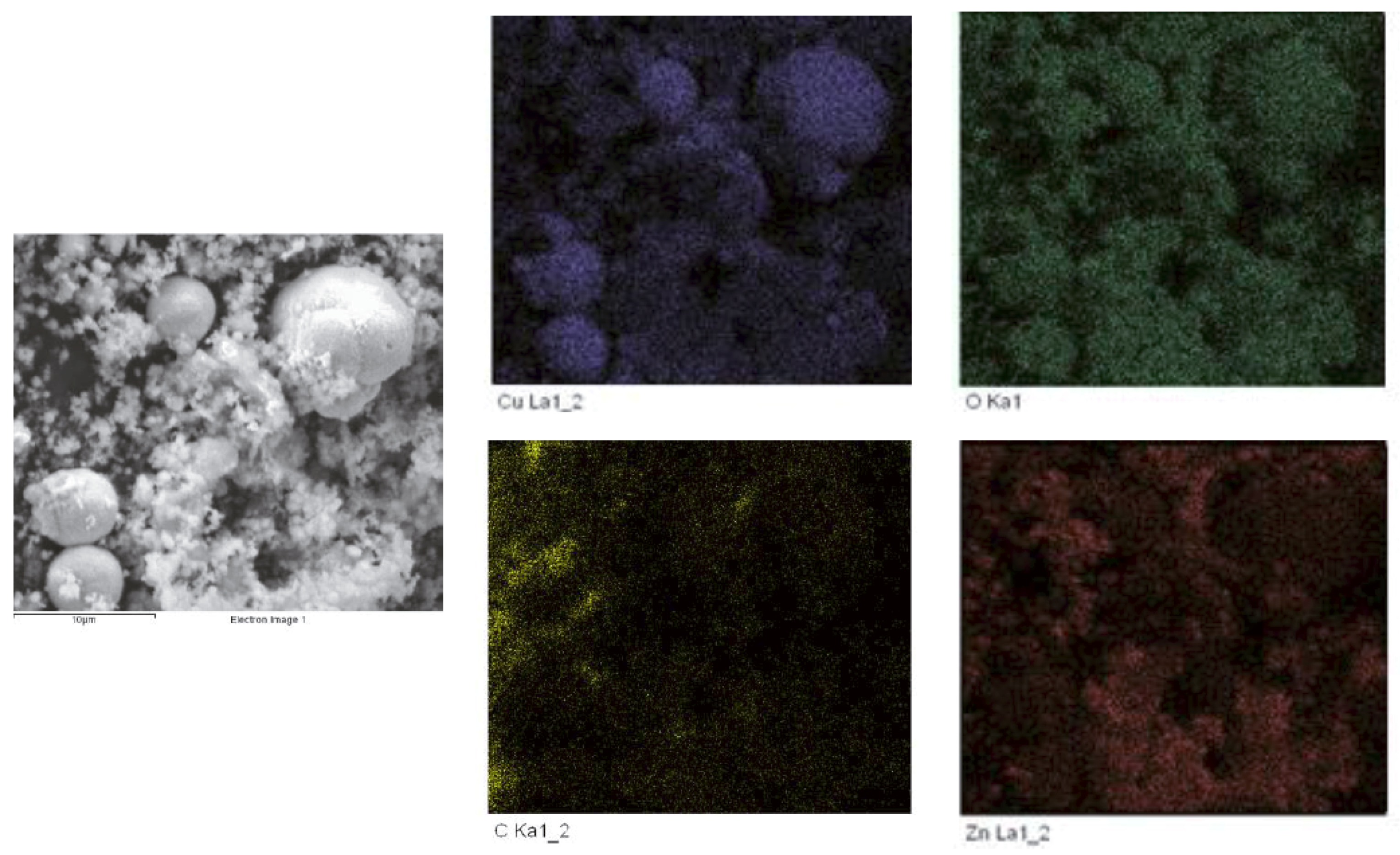
| Water Parameter | Value |
|---|---|
| pH | 7.7 ± 0.3 |
| Total alkalinity | 16 ± 0.9 mg/L as CaCO3 |
| Chloride | 35 ± 2.7 mg/L as Cl− |
| Sulfate | 18 ± 2.0 mg/L as |
| Copper | 17.2 ± 0.4 µg/L |
| CSMR (Chloride-to-sulfate mass ratio) | 1.9 |
| Lead | 2.0 ± 0.6 µg/L |
| Free chlorine residual | <0.01 mg/L as Cl2 |
| Monochloramine residual | 0.02 ± 0.01 mg/L as Cl2 |
| TOC | 0.1 mg/L |
| Sequential Sample | Conditioning | Orthophosphate (1 mg/L as P) | Orthophosphate Addition Ceased | |||||||||
|---|---|---|---|---|---|---|---|---|---|---|---|---|
| 1 d | 3 d | 7 d | Median Min, Max | 1 d | 3 d | 7 d | Median Min, Max | 1 d | 3 d | 7 d | Median Min, Max | |
| Tap 1: 0–50 mL | 0.47 −0.09, 0.97 | 0.89 0.34, 1.60 | 0.73 0.36, 1.46 | 0.64 −0.09, 1.60 | 1.55 1.50, 1.79 | 1.59 1.27, 1.92 | 1.36 1.26, 1.57 | 1.55 1.26, 1.92 | 0.97 0.74, 1.83 | 1.01 0.48, 1.44 | 0.73 0.23, 0.97 | 0.97 0.23, 1.83 |
| Tap 1: 50–100 mL | 0.24 −0.21, 0.57 | 0.64 0.32, 0.80 | 1.11 0.83, 1.30 | 0.80 −0.21, 1.30 | ||||||||
| Tap 1: 100–150 mL | 0.16 −0.22, 0.57 | 0.65 0.38, 0.86 | 0.78 0.64, 0.87 | 0.68 −0.22, 0.87 | ||||||||
| Tap 1: 150–200 mL | 0.53 0, 0.97 | 0.83 0.50, 1.00 | 0.77 0.41, 1.16 | 0.75 0, 1.16 | 1.45 1.34, 1.72 | 1.44 0.89, 1.69 | 1.30 1.23, 1.50 | 1.42 0.89, 1.72 | 0.97 0.85, 1.64 | 0.85 0.41, 1.47 | 0.33 0.17, 0.78 | 0.83 0.17, 1.64 |
| Tap 2: 0–50 mL | 0.77 0.56, 0.97 | 0.56 0.36, 0.85 | 1.15 0.52, 1.73 | 0.97 0.36, 1.73 | 1.29 1.13, 1.50 | 1.48 1.29, 1.87 | 1.38 1.25, 1.72 | 1.44 1.13, 1.87 | 0.71 0.51, 1.56 | 0.84 0.46, 1.15 | 0.52 0.40, 0.92 | 0.76 0.40, 1.56 |
| Tap 2: 50–100 mL | 0.95 0.59, 1.14 | 0.95 0.59, 1.14 | ||||||||||
| Tap 2: 100–150 mL | 0.75 0.65, 1.07 | 0.75 0.65, 1.07 | ||||||||||
| Tap 2: 150–200 mL | 0.82 0.66, 0.97 | 0.85 0.70, 1.22 | 0.90 0.52, 1.24 | 0.89 0.52, 1.24 | 1.52 1.37, 1.60 | 1.46 0.87, 1.84 | 1.30 1.22, 1.50 | 1.42 0.87, 1.84 | 1.06 0.85, 1.67 | 0.96 0.56, 1.51 | 0.63 0.41, 0.94 | 0.90 0.41, 1.67 |
| Median | 0.75 −0.22, 1.73 | 1.47 0.87, 1.92 | 0.87 0.17, 1.83 | |||||||||
© 2016 by the authors; licensee MDPI, Basel, Switzerland. This article is an open access article distributed under the terms and conditions of the Creative Commons by Attribution (CC-BY) license (http://creativecommons.org/licenses/by/4.0/).
Share and Cite
Ng, D.-Q.; Lin, Y.-P. Evaluation of Lead Release in a Simulated Lead-Free Premise Plumbing System Using a Sequential Sampling Approach. Int. J. Environ. Res. Public Health 2016, 13, 266. https://doi.org/10.3390/ijerph13030266
Ng D-Q, Lin Y-P. Evaluation of Lead Release in a Simulated Lead-Free Premise Plumbing System Using a Sequential Sampling Approach. International Journal of Environmental Research and Public Health. 2016; 13(3):266. https://doi.org/10.3390/ijerph13030266
Chicago/Turabian StyleNg, Ding-Quan, and Yi-Pin Lin. 2016. "Evaluation of Lead Release in a Simulated Lead-Free Premise Plumbing System Using a Sequential Sampling Approach" International Journal of Environmental Research and Public Health 13, no. 3: 266. https://doi.org/10.3390/ijerph13030266





